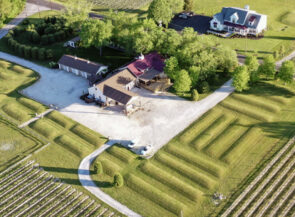After a major expansion, the Western New York art museum celebrated its grand reopening in June
From its 33 Clyfford Still paintings to its kaleidoscopic Mirrored Room, the Albright-Knox Art Gallery, in Buffalo, New York, has long boasted a world-class collection. As of this summer, the 161-year-old institution, now renamed the Buffalo AKG Art Museum, has a stunning, updated facility to match.

The museum celebrated its grand reopening in June, the culmination of a four-year expansion and a $230 million capital campaign—the largest for a cultural institution in Western New York’s history. Janne Sirén, the museum’s Peggy Pierce Elfvin director, championed the project and brought on architect Shohei Shigematsu, a partner at the firm OMA, to lead the design.
“To create a campus such as ours, knitting together historic and new architecture, is an immense and complicated task,” Sirén says. “OMA’s flexibility and willingness to devise collaborative solutions has been invaluable. Shohei and his team made every effort to understand our community’s needs and aspirations. ”

Indeed, the architect and museum leadership held a series of town hall meetings to involve the community in the planning process, and the end product is dazzling. Shigematsu, in collaboration with Cooper Robertson, designed a three-story glass structure—named for local philanthropist Jeffrey E. Gundlach, who donated $65 million to the expansion—that adds more than 30,000 square feet of exhibition space to the museum’s galleries and connects to the renovated 1905 Neo-Classical Robert and Elisabeth Wilmers Building via a serpentine glass bridge. “Shohei and OMA created a space that is both transparent and solid,” Sirén says, “one filled with light and with infinite possibilities for artists, curators, and visitors.”

The grounds underwent a total reimagination as well. Shigematsu moved the parking lot underground, replacing it with a grand lawn; restored the 1905 building’s entrance staircase, which had been removed in a previous renovation; and reoriented the campus to embrace its prized location on the edge of the Frederick Law Olmsted–designed Delaware Park. Together, these changes make for an eye-catching campus worthy of an institution that was an early supporter of Frida Kahlo, Andy Warhol, and Still, whose first museum survey show took place here. (The 33 Still paintings in the permanent collection are all on display during the inaugural exhibition.) The museum also remains home to legendary works such as Paul Gauguin’s The Yellow Christ and Jackson Pollock’s Convergence.
“The changes we have made to our historic campus enable people from all walks of life to experience and enjoy the museum’s collection, programs, special events, and so much more, whether they are citizens of Buffalo or visitors from around the world,” Sirén says. “Those of us who are lucky enough to call Buffalo home know how incredible this city is. With the opening of the Buffalo AKG, we hope to spread the word far and wide.”




